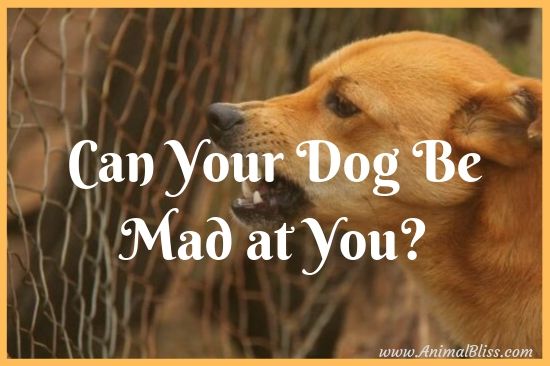Can your dog be mad at you? Well, let’s first agree that dogs do get angry, which is why they growl at strangers and other dogs. Do they get mad at their owners as well? I bet they do. Science has a lot to say about it too.
According to experts, all mammals, including dogs, have similar basic neuro-anatomy and neuro-psychology attributes that relate to emotions such as serotonin, oxytocin, and dopamine.
So, it’s no surprise that dogs have the same basic behavioral reactions as humans, including the ability to feel anger when they believe they’ve been offended.
Your dog can be mad at you, but the good news is that the reaction is usually immediate and short-lived. Dogs live in “the moment” and unlike humans will not harbor grudges or look for retribution. However, anger or rage can be exhibited in many physical or emotional ways.
There are certain behaviors your dog would not exhibit if it weren’t mad at you, but fortunately, whenever it does a simple rub or treat will help to work things out almost instantly. Most of these behaviors are easy to tell if you know your dog well.
Signs that your Dog is Upset
Lowered Head and Flattened Ears
Your dog can express anger and other emotions to you through body language. For instance, if the dog lowers its head with ears flattened, mouth closed, and lips tight, it could be a sign of anger or desire for attention.
If this happens immediately after a loud reprimand or withdrawn treats, consider it as a sign of being mad at you. The grudge won’t last long, however, especially if you give the dog a gentle scratch behind the ears. You’ll immediately be forgiven, and the issue is forgotten.
Giving You the Cold Shoulder
The cold shoulder is one funny attribute that dogs share with humans. They’ll ignore you completely if you are rude or won’t show affection. It seems as if dogs picked this habit from humans and know how much a cold shoulder will affect your emotions.
Your dog may even decide not to respond to your calls and only give you long blank stares no matter how loudly you call it. Anyway, if your dog keeps on ignoring you, know you both have a bone to pick, and you better take time to give the dog an apologetic pat or a treat to start mending fences.
Related:
Teach Your Dog Good Behavior, Obedience Training Guide
Chewing and Peeing Rage
Dogs have other gross ways of expressing anger. They’ll not just pee on your pillow but even chew up your shoes, slippers, and other items when they have an emotional problem. And we are not talking about puppies here but full-grown dogs.
Don’t throw more anger at the dog when this happens. Try to find the root cause of the problem and make sure the dog has enough toys to vent on when offended.
Sudden Stubbornness
Stubbornness and refusal to obey commands are classic responses of an angry dog. If your dog typically sits, stays, rolls over, and usually obeys your commands but suddenly refuses to do anything you tell them to, take this as an emotional reaction to something you have just done. Dogs are quite perceptive and know when you are stressed or angry.
They’ll not be playful when they sense bad vibes in your home. In this case, calm yourself before you attempt to comfort your dog.
The Tucked-In Tail Expression
We all know dogs tuck in their tails when they are afraid of something or someone put fear and anger go hand in hand in most cases. Dogs tuck in their tails when they are defensive or intimidated.
If your dog cowers before you after a loud reprimand, consider this as a sign of anger and a need for reassurance that you are no longer angry with it.
Moaning and Groaning
This reaction is quite obvious. If you lock your dog far away from you in a place it doesn’t want to be, it won’t stop moaning and groaning as a way of expressing their sadness and anger at you.
Growling
A growl characterizes extreme emotions such as anger or physical pain. A dog growls when upset about something and is probably telling you that the situation it’s facing is becoming unbearable. Growling is a sign of anger.
Conclusion
What should you do when your dog shows signs of anger? The first thing you should do is try to calm down the dog with a gentle rub. Then try to diagnose the cause of the anger.
If the dog keeps exhibiting signs of agitation, anger, unresponsiveness, or depression, get professional help from a vet to ensure that the emotions are not due to a painful illness or injury.
~~~~~
“Can Your Dog Be Mad at You? Read the Signs”
Guest Writer: Kimberly Johnson is a founder of The Hunting Dog, a website which provides research and information about hunting breeds of dogs.
- 4 Tips for Maintaining Healthy Weight for Your Cat - December 20, 2019
- 8 Amazing Benefits of CBD for Dogs and Other Pets - December 12, 2019
- Kibble or Canned Pet Food? What Should Your Pet Be Eating? - December 9, 2019

